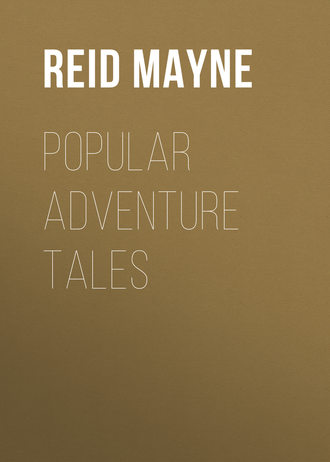
Майн Рид
Popular Adventure Tales
CHAPTER XLVI.
THE “GAPO.”
After many days of rafting our travellers arrived in a most singular country. They were now approaching the mighty Amazon, and the river upon which they had hitherto been travelling appeared to divide into many branches, where it formed deltas with the Amazon. Every day, and sometimes two or three times in the day, they passed places where the river forked, as though each branch passed round an island, but our travellers perceived that these branches did not meet again; and they conjectured that they all fell into the Amazon by separate embouchures. They were often puzzled to know which one to take, as the main river was not always broadest, and they might get into one that was not navigable below. A curious region it was through which they passed; for, in fact, they were now travelling in the country of the “Gapo.”
What is the “Gapo?” you will ask. The “Gapo,” then, is the name given to vast tracts of country upon the Amazon and some of its tributary streams, that are annually inundated, and remain under water for several months in the year. It extends for hundreds of miles along the Amazon itself, and up many of the rivers, its tributaries also, for hundreds of miles.
But the whole country does not become one clear sheet of water, as is the case with floods in other parts of the world. On the contrary, high as is the flood, the tree-tops and their branches rise still higher, and we have in the “Gapo” the extraordinary spectacle of a flooded forest, thousands of square miles in extent!
In this forest the trees do not perish, but retain life and verdure. In fact, the trees of this part are peculiar, most of them differing in kind from the trees of any other region. There are species of palms growing in the “Gapo” that are found nowhere else; and there are animals and birds, too, that remain in this region during the whole season of flood. It has been further asserted that there are tribes of “Gapo” Indians, who live in the middle of the inundation, making their dwellings upon the trees, and who can pass from branch to branch and tree to tree almost as nimbly as monkeys.
This may or may not be true. It would not be a new thing, if true, for it is well known that the Guarano Indians, at the mouth of the Orinoco, dwell among the tops of the murichi palms during many months of the season of flood. These people build platforms on the palms, and upon these erect roofs, and sling their hammocks, and, with little fireplaces of mud, are enabled to cook their provisions upon them. But they have canoes, in which they are able to go from place to place, and capture fish, upon which they principally subsist. The murichi palm furnishes them with all the other necessaries of life.
This singular tree is one of the noblest of the palms. It rises to a height of more than one hundred feet, and grows in immense palmares, or palm-woods, often covering the bank of the river for miles. It is one of those called “fan-palm” – that is, the leaves, instead of being pinnate or feathery, have long naked stalks, at the end of which the leaflets spread out circularly, forming a shape like a fan. One of the murichi leaves is a grand sight. The leaf-stalk, or petiole, is a foot thick where it sprouts from the trunk; and before it reaches the leaflets it is a solid beam of ten or twelve feet long, while the circular fan or leaf itself is nine or ten in diameter! A single leaf of the murichi palm is a full load for a man.
With a score of such leaves, – shining and ever verdant as they are, – at the top of its column-like trunk, what a majestic tree is the murichi palm!
But it is not more beautiful than useful. Its leaves, fruit, and stem, are all put to some use in the domestic economy of the Indians. The leaf-stalk, when dried, is light and elastic, like the quill of a bird – owing to the thin, hard, outer covering and soft internal pith. Out of the outer rind, when split off, the Indian makes baskets and window-blinds. The pithy part is separated into laths, about half an inch thick, with which window-shutters, boxes, bird-cages, partitions, and even entire walls, are constructed.
The epidermis of the leaves furnishes the strings for hammocks and all kinds of cordage. From the fruits a favourite beverage is produced, and these fruits are also pleasant eating, somewhat resembling apples. They are in appearance like pine-cones, of a red colour outside and yellow pulp. The trunk itself furnishes a pith or marrow that can be used as sago; and out of the wood the Indian cuts his buoyant canoe! In short, there are tribes of Indians that not only live, in a literal sense, on the murichi palms, but that almost subsist on them.
Although the flood had, to a considerable extent, subsided, the river in most places was still beyond its banks; and this made it difficult for our travellers to find a place for their night-camps. Several nights they were obliged to sleep, as they best could, on the balza, – the latter being secured to a tree. Sometimes, by pushing some distance up the mouth of an “igaripé,” or creek, they were able to find dry ground, on which to encamp. During their passage through this labyrinth of rivers, they travelled but very slowly, and their provisions were fast running out. There was no chance for increasing their stock, as they could not find either wild-hogs (peccaries) or capivaras. These creatures, although they can swim well enough, would only be found upon the banks of the river, when it returned within its proper channel.
Now and then Guapo brought down a parrot, a macaw, or an aracari, with his blow-gun; but these were only temporary supplies. They had often heard howling monkeys in the trees, but had not been able to see them; and none of the party would have refused to eat roast-monkey now, as they had all tried it and found it quite palatable. Guapo, blow-gun in hand, was continually peering up among the tree-tops in search of monkeys or other game. He was, at length, rewarded for his vigilance.
One night they had pushed the balza up an “igaripé” for a hundred yards or so, where a dry bank gave them an opportunity of landing. The creek itself was not much wider than the balza, and tall trees stood upon both banks. In one or two places the thorny “jacitara” palm – which is a sort of climbing plant, often hanging over the branches of other trees – nearly reached across the stream. These curious palms had even to be cautiously pushed to one side as the balza passed, – for the arrowy claws upon them, if once hooked into the clothes of passengers, would either have dragged the latter from off the raft, or have torn out the piece of cloth.
CHAPTER XLVII.
THE ARAGUATOES
Our party had passed several of these jacitaras, made the balza fast, landed, and were just cooking their scanty supper, when they heard a band of howling monkeys afar off in the woods. There was nothing unusual in this; for these creatures are heard at all times among the forests of the Amazon, especially at sunrise and before sunset, or whenever there is any appearance of the approach of a rain-storm.
Our travellers would not have noticed their voices on this occasion, but that they seemed to be approaching in that direction; and as they were coming along the bank of the main river, Guapo concluded that on arriving at the “igaripé” they would turn up it and pass near where the balza was, and thus he might have them within reach of his gravatána. It was certain they were coming down the river side – of course upon the tree-tops, and would, no doubt, turn up as Guapo expected, for the trees on the opposite side of the igaripé stood too far apart even for monkeys to spring across.
After waiting for half-an-hour or so, the hideous howling of the monkeys could be heard at no great distance, and they were taking the desired route. In fact, in a few minutes after, the troop appeared upon some tall trees that stood on the edge of the creek, not fifty yards from where the balza was moored. They were large animals, of that lanky and slender shape that characterises the prehensile-tailed monkeys; but these were different from the ateles already mentioned. They were true howlers, as they had already proved by the cries they had been uttering for the half-hour past.
There are several species of howling monkeys, as we have already stated. Those that had arrived on the igaripé Guapo pronounced to be araguatoes. Their bodies are of a reddish-brown colour on the body and shoulders, lighter underneath, and their naked wrinkled faces are of a bluish black, and with very much of the expression of an old man. Their hair is full and bushy, and gives them some resemblance to a bear, whence their occasional name of “bear-ape,” and also their zoological designation, Simia ursina. The araguato is full three feet without the tail, and that powerful member is much longer.
When the band made its appearance on the igaripé, they were seen to come to a halt, all of them gathering into a great tree that stood by the water's edge. This tree rose higher than the rest, and the most of the monkeys having climbed among the top branches, were visible from the balza. There were about fifty in the troop, and one that seemed larger than any of the others appeared to act as leader. Many of them were females, and there were not a few that had young ones, which they carried upon their backs just as the Indian mothers and those of other savage nations carry their children.
Most of the little monkeys lay along the backs of their mothers, clasping them around the neck with their fore-arms, while their hind ones girdled the middle of the body. But it was in their tails the little fellows seemed to place most reliance. The top parts of these were firmly lapped around the thick base of the tails of the old ones, and thus not only secured their seat, but made it quite impossible for them to drop off. No force could have shaken them from this hold, without dragging out their tails or tearing their bodies to pieces, indeed, it was necessary they should be thus firmly seated, as the exertions of the mothers, – their quick motions and long springing leaps from tree to tree – would otherwise have been impossible.
On reaching the bank of the igaripé, the araguatoes were evidently at fault. Their intention had been to proceed down along the main river, and the creek now interfered. Its water lay directly across their course, and how were they to get over it? Swim it, you may, say. Ha! little do you know the dread these creatures have of water. Yes; strange to say, although many species of them pass their lives upon trees that overhang water, or even grow out of it, they are as much afraid of the water beneath them as if it were fire. A cat is not half so dainty about wetting her feet as some monkeys are; and besides a cat can swim, which the monkeys cannot – at best so badly that in a few minutes they would drown.
Strange, is it not, that among animals, those that approach nearest to man, like him are not gifted by nature with the power of swimming? It is evident, then, that that is an art left to be discovered by the intellect of man. To fall into the water would be a sad mishap for a monkey, not only on account of the ducking, but of the danger. There is not much likelihood of an araguato falling in. Even though one branch may have broken and failed it, in the great concave sphere which it can so quickly trace around it by means of its five long members, it is sure of finding a second. No; the araguatoes might spend a life-time in the flooded forest without even wetting a hair farther than what is wetted by the rain.
From their movements, it was evident the igaripé had puzzled them; and a consultation was called among the branches of the tall tree already mentioned. Upon one of the very highest sat the large old fellow who was evidently leader of the band. His harangue was loud and long, accompanied by many gestures of his hands, head, and tail. It was, no doubt, exceedingly eloquent. Similar speeches delivered by other old araguato chiefs, have been compared to the creaking of an ungreased bullock-cart, mingled with the rumbling of the wheels!
Our party thought the comparison a just one. The old chief finished at length. Up to this point not one of the others had said a word. They all sat silent, observing perfect decorum; indeed, much greater than is observed in the great British Parliament or the Congress of America. Occasionally one of the children might utter a slight squeak, or throw out its hand to catch a mosquito; but in such cases a slap from the paw of the mother, or a rough shaking, soon reduced it to quiet.
When the chief had ended speaking, however, no debate in either Congress or Parliament could have equalled the noise that then arose. Every araguato seemed to have something to say, and all spoke at the same time. If the speech of the old one was like the creaking of a bullock-cart, the voices of all combined might appropriately be compared to a whole string of these vehicles, with half the quantity of grease and a double allowance of wheels!
Once more the chief, by a sign, commanded silence, and the rest became mute and motionless as before.
This time the speech of the leader appeared to refer to the business in hand – in short, to the crossing of the igaripé. He was seen repeatedly pointing in that direction, as he spoke, and the rest followed his motions with their eyes.
CHAPTER XLVIII.
BRIDGING AN IGARIPÉ
The tree upon which the araguatoes were assembled stood near the edge of the water, but there was another still nearer. This was also a tall tree free of branches for a great way up. On the opposite bank of the igaripé was a very similar tree, and the long horizontal branches of the two were separated from each other by a space of about twenty feet. It was with these two trees that the attention of the araguatoes appeared to be occupied; and our travellers could tell by their looks and gestures that they were conversing about, and calculating, the distance between their upper branches. For what purpose?
Surely they do not expect to be able to make a crossing between them? No creature without wings could pass from one to the other! Such were the questions and doubts expressed by Leon, and indeed by all except Guapo, but Guapo had seen araguatoes before, and knew some of their tricks. Guapo, therefore, boldly pronounced that it was their intention to cross the igaripé by these two trees. He was about to explain the manner in which they would accomplish it, when the movement commenced, and rendered his explanation quite unnecessary.
At a commanding cry from the chief, several of the largest and strongest monkeys swung themselves into the tree that stood on the edge of the water. Here, after a moment's reconnoissance, they were seen to get upon a horizontal limb – one that projected diagonally over the igaripé. There were no limbs immediately underneath it on the same side of the tree; and for this very reason had they selected it. Having advanced until they were near its top, the foremost of the monkeys let himself down upon his tail, and hung head downward. Another slipped down the body of the first, and clutched him around the neck and fore-arms with his strong tail, with his head down also. A third succeeded the second, and a fourth the third, and so on until a string of monkeys dangled from the limb.
A motion was now produced by the monkeys striking other branches with their feet, until the long string oscillated back and forwards like the pendulum of a clock. This oscillation was gradually increased, until the monkey at the lower end was swung up among the branches of the tree on the opposite side of the igaripé. After touching them once or twice, he discovered that he was within reach; and the next time when he had reached the highest point of the oscillating curve, he threw out his long thin fore-arms, and firmly clutching the branches, held fast.
The oscillation now ceased. The living chain stretched across the igaripé from tree to tree, and, curving slightly, hung like a suspension-bridge! A loud screaming, and gabbling, and chattering, and howling, proceeded from the band of araguatoes, who, up to this time, had watched the manœuvres of their comrades in silence – all except the old chief, who occasionally had given directions both with voice and gestures. But the general gabble that succeeded was, no doubt, an expression of the satisfaction of all that the bridge was built.
The troop now proceeded to cross over, one or two old ones going first, perhaps to try the strength of the bridge. Then went the mothers carrying their young on their backs, and after them the rest of the band.
It was quite an amusing scene to witness, and the behaviour of the monkeys would have caused any one to laugh. Even Guapo could not restrain his mirth at seeing those who formed the bridge biting the others that passed over them, both on the legs and tails, until the latter screamed again!
The old chief stood at the near end and directed the crossing. Like a brave officer, he was the last to pass over. When all the others had preceded him, he crossed after, carrying himself in a stately and dignified manner. None dared to bite at his legs. They knew better than play off their tricks on him, and he crossed quietly and without any molestation.
Now the string still remained suspended between the trees. How were the monkeys that formed it to get themselves free again? Of course the one that had clutched the branch with his arms might easily let go, but that would bring them back to the same side from which they had started, and would separate them from the rest of the band. Those constituting the bridge would, therefore, be as far from crossing as ever!
There seemed to be a difficulty here – that is, to some of our travellers. To the monkeys themselves there was none. They knew well enough what they were about, and they would have got over the apparent difficulty in the following manner: – The one at the tail end of the bridge would simply have let go his hold, and the whole string would then have swung over and hung from the tree on the opposite bank, into which they could have climbed at their leisure. I say they would have done so had nothing interfered to prevent them from completing the manœuvre. But an obstacle intervened which brought the affair to a very different termination.
Guapo had been seated along with the rest, gravatána in hand. He showed great forbearance in not having used the gravatána long before, for he was all the while quite within reach of the araguatoes; but this forbearance on his part was not of his own freewill. Don Pablo had, in fact, hindered him, in order that he and the others, should have an opportunity of witnessing the singular manœuvres of the monkeys. Before the scene was quite over, however, the Indian begged Don Pablo to let him shoot, reminding him how much they stood in need of a little “monkey-meat.” This had the effect Guapo desired; the consent was given, and the gravatána was pointed diagonally upwards. Once more Guapo's cheeks were distended – once more came the strong, quick puff – and away went the arrow. The next moment it was seen sticking in the neck of one of the monkeys.
Now, the one which Guapo had aimed at and hit was that which had grasped the tree on the opposite side with its arms. Why did he chose this more than any other? Was it because it was nearer, or more exposed to view? Neither of these was the reason. It was, that had he shot any of the others in the string – they being supported by their tails – it would not have fallen; the tail, as we have already seen, still retaining its prehensile power even to death. But that one which held on to the tree by its fore-arms would in a second or two be compelled from weakness to let go, and the whole chain would drop back on the near side of the igaripé. This was just what Guapo desired, and he waited for the result. It was necessary only to wait half-a-dozen seconds. The monkey was evidently growing weak under the influence of the curare, and was struggling to retain its hold. In a moment it must let go.
The araguato at the “tail-end” of the bridge, not knowing what had happened, and thinking all was right for swinging himself across, slipped his tail from the branch just at the very same instant that the wounded one let go, and the whole chain fell “souse” into the water! Then the screaming and howling from those on shore, the plunging and splashing of the monkeys in the stream, mingled with the shouts of Leon, Guapo, and the others, created a scene of noise and confusion that lasted for several minutes. In the midst of it, Guapo threw himself into the canoe, and with a single stroke of his paddle shot right down among the drowning monkeys. One or two escaped to the bank, and made off; several went to the bottom;, but three, including the wounded one, fell into the clutches of the hunter.
Of course roast-monkey was added to the supper; but none of the travellers slept very well after it, as the araguatoes, lamenting their lost companions, kept up a most dismal wailing throughout the whole of the night.







